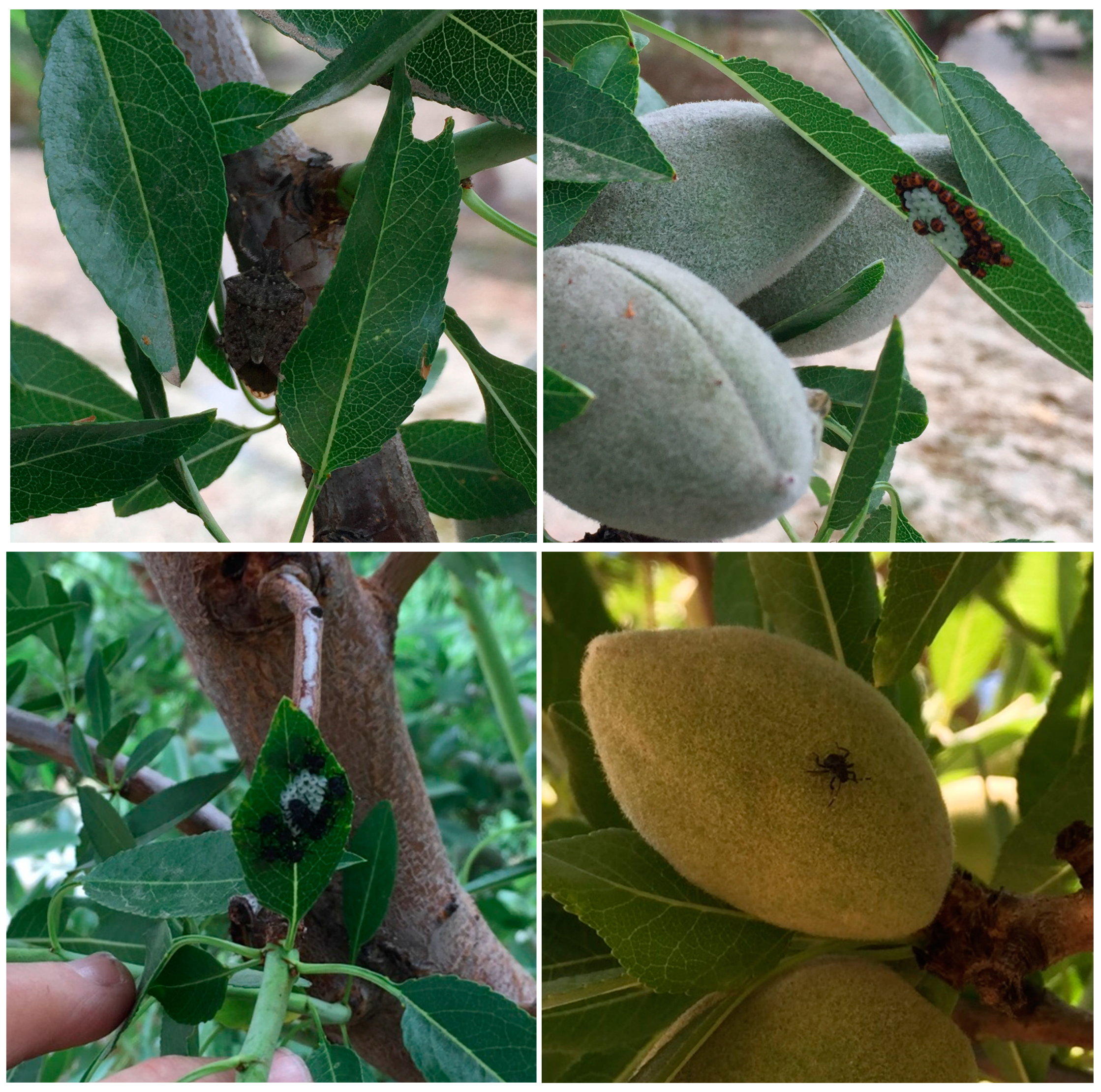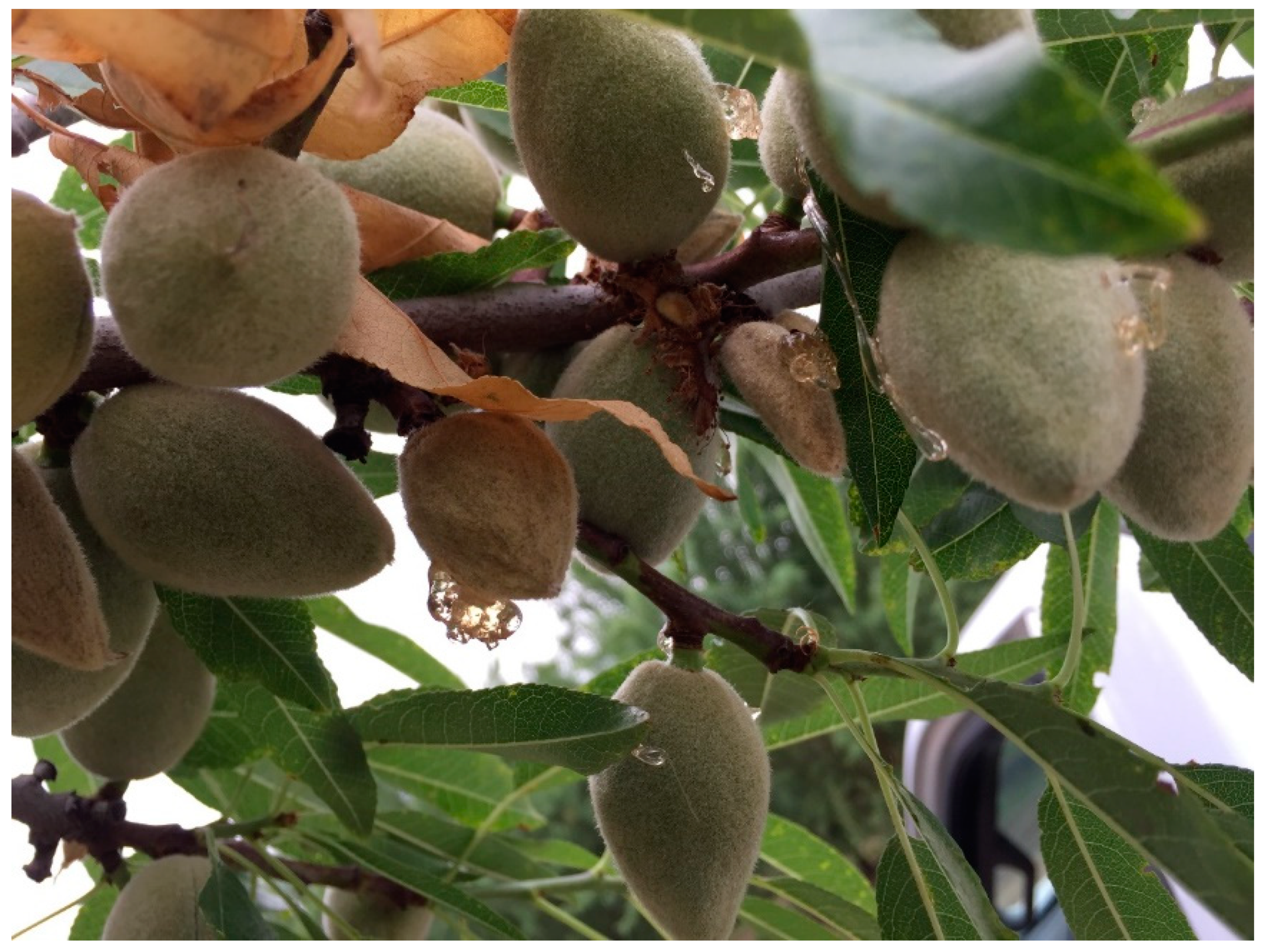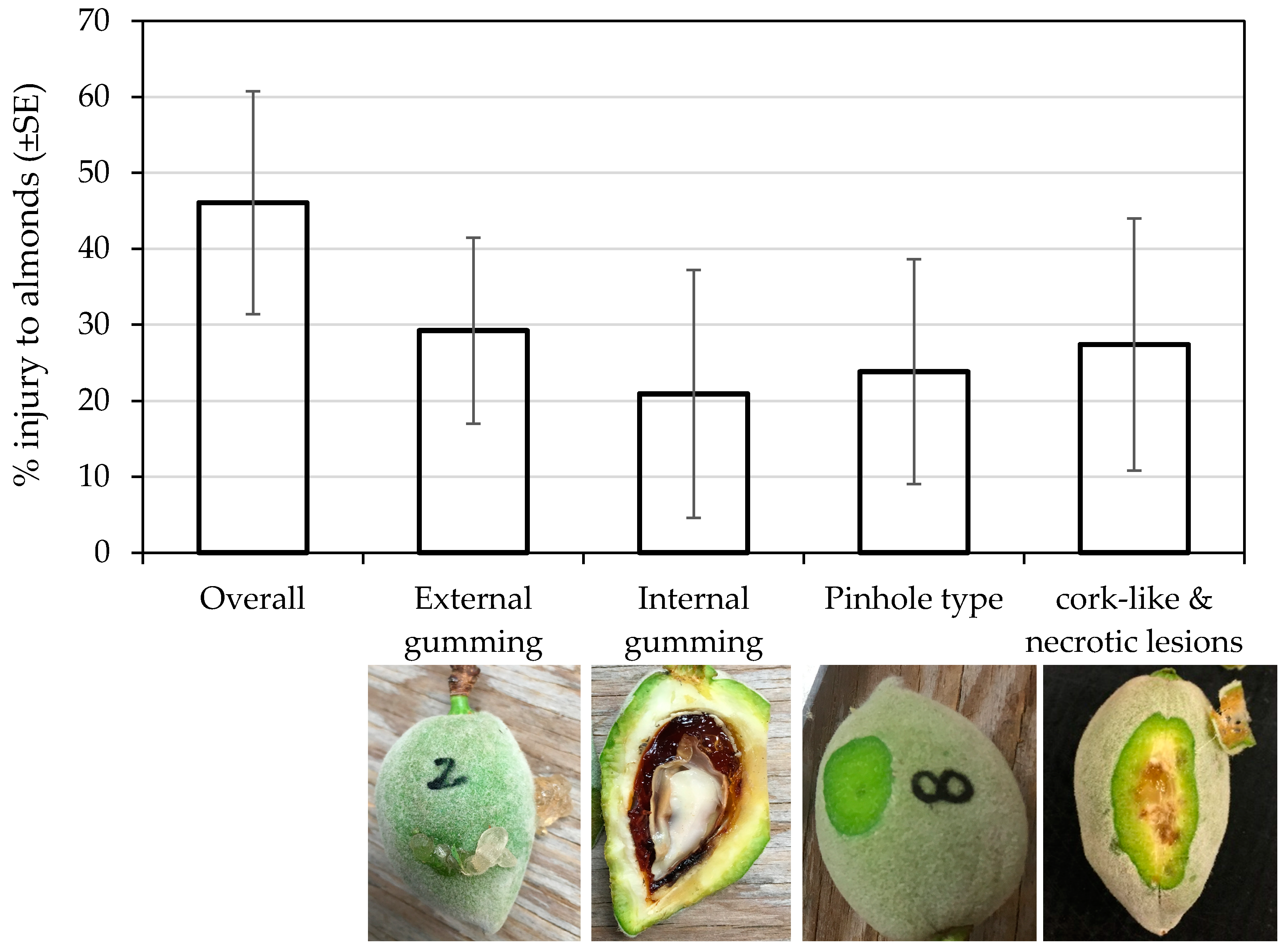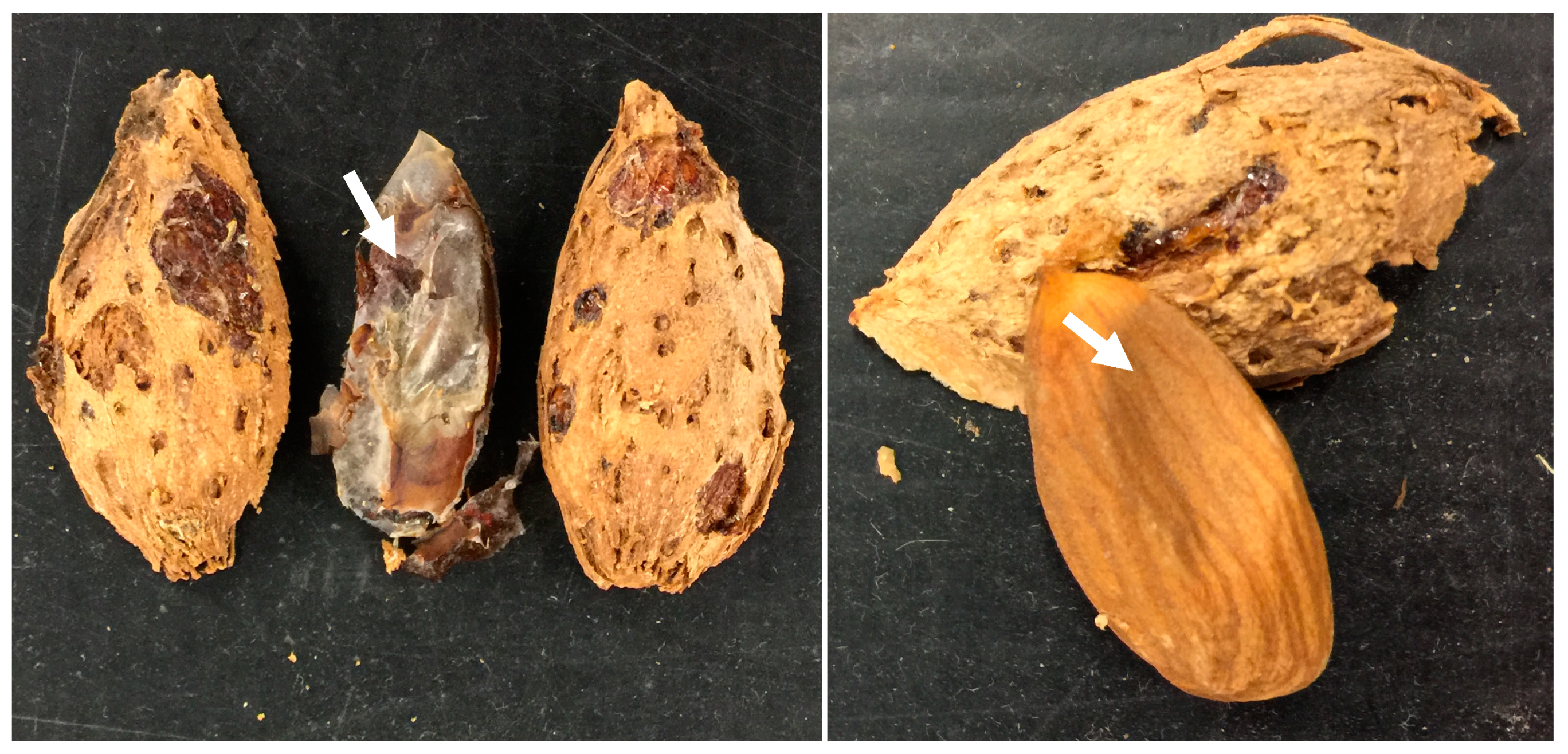Characterizing Brown Marmorated Stink Bug Injury in Almond, a New Host Crop in California
Abstract
1. Introduction
2. Materials and Methods
2.1. Brown Marmorated Stink Bug Activity in Almond Orchard
2.2. In-Situ Injury Evaluation
2.3. Assessment of H. halys Damage to Developing Nuts
2.4. Assessment of H. halys Damage to Harvested Nuts
3. Results and Discussion
4. Conclusions
Author Contributions
Funding
Acknowledgments
Conflicts of Interest
References
- Leskey, T.C.; Hamilton, G.C.; Nielsen, A.L.; Polk, D.F.; Rodriguez-Saona, C.; Bergh, J.C.; Herbert, D.A. Pest status of the brown marmorated stink bug, Halyomorpha halys in the USA. Outlooks Pest Manag. 2012, 5, 218–226. [Google Scholar] [CrossRef]
- Rice, K.B.; Bergh, C.J.; Bergmann, E.J.; Biddinger, D.J.; Dieckhoff, C.; Dively, G.; Fraser, H.; Gariepy, T.; Hamilton, G.; Haye, T.; et al. Biology, ecology, and management of brown marmorated stink bug (Hemiptera: Pentatomidae). J. Integr. Pest Manag. 2014, 5, A1–A13. [Google Scholar] [CrossRef]
- Leskey, T.C.; Nielsen, A.L. Impact of the invasive brown marmorated stink bug in North America and Europe: History, biology, ecology, and management. Annu. Rev. Entomol. 2017, 63, 599–618. [Google Scholar] [CrossRef] [PubMed]
- Hoebeke, E.R.; Carter, M.E. Halyomorpha halys (Stal) (Heteroptera: Pentatomidae): A polyphagous plant pest from Asia newly detected in North America. Proc. Entomol. Soc. Wash. 2003, 105, 225–237. [Google Scholar]
- Lee, D.H.; Cullum, J.P.; Anderson, J.L.; Daugherty, J.L.; Beckett, L.M.; Leskey, T.C. Characterization of overwintering sites of the invasive brown marmorated stink bug in natural landscapes using human surveyors and detector canines. PLoS ONE 2003, 9, e91575. [Google Scholar] [CrossRef] [PubMed]
- Bergh, J.C.; Morrison, W.R.; Joseph, S.V.; Leskey, T.C. Characterizing spring emergence of adult Halyomorpha halys using experimental overwintering shelters and commercial pheromone traps. Entomol. Exp. Appl. 2017, 162, 336–345. [Google Scholar] [CrossRef]
- Wiman, N.G.; Walton, V.M.; Shearer, P.W.; Rondon, S.I.; Lee, J.C. Factors affecting flight capacity of brown marmorated stink bug, Halyomorpha halys (Hemiptera: Pentatomidae). J. Pest Sci. 2015, 88, 37–47. [Google Scholar] [CrossRef]
- Holthouse, M.C.; Alston, D.G.; Spears, L.R.; Petrizzo, E. Brown Marmorated Stink bug (Halyomorpha halys (Stål)). Available online: https://digitalcommons.usu.edu/cgi/viewcontent.cgi?article=2785&context=extension_curall (accessed on 20 September 2018).
- Hedstrom, C.S.; Shearer, P.W.; Miller, J.C.; Walton, V.M. The effects of kernel feeding by Halyomorpha halys (Hemiptera: Pentatomidae) on commercial hazelnuts. J. Econ. Entomol. 2014, 107, 1858–1865. [Google Scholar] [CrossRef] [PubMed]
- Lara, J.; Pickett, C.; Ingels, C.; Haviland, D.; Grafton-Cardwell, E.; Doll, D.; Bethke, J.; Fabe, B.; Dara, S.; Hoddle, M. Biological control program is being developed for brown marmorated stink bug. Calif. Agric. 2016, 70, 15–23. [Google Scholar] [CrossRef]
- Ingels, C.; Varela, L. Brown Marmorated Stink Bug. Available online: http://ipm.ucanr.edu/PMG/PESTNOTES/pn74169.html (accessed on 20 September 2018).
- Ingels, C.; Daane, K. Phenology of brown marmorated stink bug in a California urban landscape. J. Econ. Entomol. 2018, 111, 780–786. [Google Scholar] [CrossRef] [PubMed]
- Anonymous. Center for Invasive Species Research, University of California Riverside. Available online: http: //cisr.ucr.edu/images/cisr_H. halys_distribution_large.jpg (accessed on 2 June 2018).
- Rijal, J.P.; Duncan, R. First report of an established brown marmorated stink bug (Hemiptera: Pentatomidae) population in California agricultural crops. J. Entomol. Sci. 2017, 53, 450–454. [Google Scholar] [CrossRef]
- Rijal, J.P.; Duncan, R. Monitoring of Brown Marmorated Stink Bug in the Northern San Joaquin Valley Peach Orchards; Annual Report-California Cling Peach Board: Sacramento, CA, USA, 2016; 5p. [Google Scholar]
- Daane, K.; Yokota, G.; Krugner, R.; Steffan, S.; da Silva, P.; Beede, R.; Weinberger, G. Large bugs damage pistachio nuts most severely during midseason. Calif. Agric. 2005, 59, 95–102. [Google Scholar] [CrossRef]
- University of California Integrated Pest Management. Almonds Pest Management Guidelines. 2016. Available online: http://ipm.ucanr.edu/PMG/selectnewpest.almonds.html (accessed on 8 July 2018).
- Leskey, T.C.; Short, B.D.; Butler, B.R.; Wright, S.E. Impact of the invasive brown marmorated stink bug, Halyomorpha halys (Stål), in mid-Atlantic tree fruit orchards in the United States: Case studies of commercial management. Psyche 2012, 2012. [Google Scholar] [CrossRef]
- Joseph, S.V.; Nita, M.; Leskey, T.C.; Bergh, J.C. Temporal effects on the incidence and severity of brown marmorated stink bug (Hemiptera: Pentatomidae) feeding injury to peaches and apples during the fruiting period in Virginia. J. Econ. Entomol. 2015, 108, 592–599. [Google Scholar] [CrossRef] [PubMed]
- Acebes-Doria, A.; Leskey, T.C.; Bergh, J.C. Injury to apples and peaches at harvest from feeding by Halyomorpha halys (Stål) (Hemiptera: Pentatomidae) nymphs early and late in the season. Crop Prot. 2016, 89, 58–65. [Google Scholar] [CrossRef]
- Peiffer, M.; Felton, G.W. Insights into the saliva of the brown marmorated stink bug Halyomorpha halys (Hemiptera: Pentatomidae). PLoS ONE 2014, 9, e88483. [Google Scholar] [CrossRef] [PubMed]
- Lara, J.R.; Kamiyama, M.T.; Hernandez, G.; Nay, J.; Hoddle, M.S. Assessment of feeding acceptance and injury of Kerman pistachios, Pistacia vera, by brown marmorated stink bug (Hemiptera: Pentatomidae). J. Insect Sci. 2017, 17. [Google Scholar] [CrossRef] [PubMed]
- California Department of Food and Agriculture (CDFA). Agricultural Statistical Overview 2016–2017; California Department of Food and Agriculture: Sacramento, CA, USA, 2017.
- NASS. National Agricultural Statistics Service. 2017. Available online: https://www.nass.usda.gov/Statistics_by_State/California/Publications/Specialty_and_Other_Releases/Almond/Acreage/201804almac.pdf (accessed on 10 June 2018).






| Sample Tree | Gumming Nuts (%) | ||
|---|---|---|---|
| 1st Row | 2nd Row | 3rd Row | |
| 1 | 27.66 (N = 47) | 58.34 (N = 24) | 27.50 (N = 40) |
| 2 | 8.11 (N = 37) | 18.19 (N = 22) | 20.52 (N = 39) |
| 3 | 11.96 (N = 92) | 22.86 (N = 35) | 19.61 (N = 51) |
| 4 | 18.52 (N = 27) | 26.20 (N = 42) | 24.40 (N = 41) |
| 5 | 12.50 (N = 16) | 14.71 (N = 34) | 18.19 (N = 33) |
| Average | 15.75 | 28.06 | 22.04 |
| Overall mean | 21.95 | ||
© 2018 by the authors. Licensee MDPI, Basel, Switzerland. This article is an open access article distributed under the terms and conditions of the Creative Commons Attribution (CC BY) license (http://creativecommons.org/licenses/by/4.0/).
Share and Cite
Rijal, J.; Gyawaly, S. Characterizing Brown Marmorated Stink Bug Injury in Almond, a New Host Crop in California. Insects 2018, 9, 126. https://doi.org/10.3390/insects9040126
Rijal J, Gyawaly S. Characterizing Brown Marmorated Stink Bug Injury in Almond, a New Host Crop in California. Insects. 2018; 9(4):126. https://doi.org/10.3390/insects9040126
Chicago/Turabian StyleRijal, Jhalendra, and Sudan Gyawaly. 2018. "Characterizing Brown Marmorated Stink Bug Injury in Almond, a New Host Crop in California" Insects 9, no. 4: 126. https://doi.org/10.3390/insects9040126
APA StyleRijal, J., & Gyawaly, S. (2018). Characterizing Brown Marmorated Stink Bug Injury in Almond, a New Host Crop in California. Insects, 9(4), 126. https://doi.org/10.3390/insects9040126





